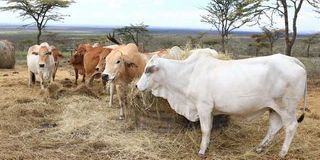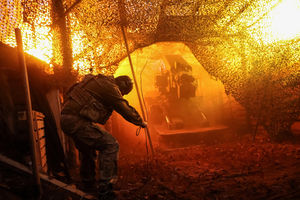Premium
Kenya needs to focus on producing high quality beef

Boran cows in Ol Pejeta, Laikipia County, on April 8, 2021. These local breeds take long to mature compared to exotic ones. Joseph Kanyi | Nation Media Group
In the last two years, I have had many enquiries on beef production. Most enquiries asserted that beef farming was more profitable than dairy.
My response has been that the assertion is inaccurate because profitability in beef and dairy farming depends on the production and marketing strategies.
If in both cases, the feeds are purchased in full or the bigger part, then the business becomes unprofitable unless the farmer is serving a very high-end market.
The term high-end gives an impression of opulence in many people.
However, it may just mean a market that consumes the products at very high prices but the product is sold in small units. This is the “kadogo economy”; a convenient but expensive supply chain.
I recall one farmer in the heart of Korogocho village, Nairobi. When he called me to go treat his eight dairy cows, I was hesitant because I could not understand how he kept the animals in the slum.
The place was barely accessible with a vehicle due to the narrow allays to where the cows were housed.
When I got there, I found he depended on purchased feeds but he was able to sell a litre of milk at Sh60 when the market price was Sh12.
He sold his milk in small quantities from a quarter glass and never more than a quarter litre. The milk had ready customers and was always sold out due to convenience and supply of the small quantities on demand by a large number of buyers.
The Korogocho dairy farmer also sold meat at his butchery in the same area.
I got interested to know how he was dealing with meat sales. Again, I learnt that his most frequent quantity of sale was one eighth and one sixteenth of a kilogramme – that is 125 and about 63 grams.
At the time I visited the farmer, there were no digital scales and the lowest weight of measure was 125g.
To measure 63 grams, the farmer-butcher would weigh 125 grams then split it roughly in the middle and dispense as a sixteenth of a kilo.
The farmer kept some bulls and zebu cattle in another location near Nairobi. He would slaughter them for his butchery.
Anyway, “kadogo economy” is an opportunistic and unsustainable business model which is also to a great extent illegal. Consumers tend to be exploited deliberately or inadvertently.
They tolerate the exploitation due to the convenience of supply at quantities they can afford.
The other high-end market is the one in which consumers are willing to pay premium prices for high quality products.
There are, for instance, butcheries that sell high quality beef in cuts at up to Sh1,500 a kilo.
The challenge with high-end markets of the two extremes is that they are few and are highly depend on socio-economic dynamics.
For instance, if the consumers in the kadogo economy prosper, they automatically transition into the regular economy where units of measure are regulated and prices are the prevailing market prices.
On the contrary, if the economy deteriorates, some high-end market consumers of opulence lower their consumption habits to the regular economy. In both cases, producers supplying the two markets would suffer and possibly close their businesses.
The recommended production method is to remain within the regular market prices, the premium market or both.
This means farmers producing beef should concentrate more on working with animals that produce good quality beef and pack the meat fast in relation to the age of the animal.
Kenya heavily relies on the Small East African Zebu (SEAZ), Boran and Sahiwal breeds for meat production.
These cattle belong to the tropical breeds called the Bos indicus group.
The animals are mainly reared in the rangelands or arid and semi-arid lands. The cattle are reared on free range pasture and take long to attain economical slaughter weight.
They are slaughtered at five and seven years when the meat is tough and not very tasty.
The three breeds mostly slaughtered in Kenya are slow growers and cost feedlot farmers a lot because they also gain weight slowly during fattening and finishing.
The lucrative export market is also demanding a change in the breed of beef animals. They prefer the European breeds, called the Bos taurus.
I recall one of my clients who had a big annual order of 12,000 beef steers of 400-500kg live weight for Mauritius.
He could not supply because the market needed Bos taurus breeds or cross breeds with Bos indicus.
Examples of Bos taurus breeds are the dairy breeds and the beef breeds of Hereford, Charolais and Angus.
Others are the Santa Gertrudis, Fleckvieh and Belgian blue.
These animals and their crosses with Bos indicus are fast growers, put on weight quickly and have very juicy and tasty meet.
They attain 400-700kg live weight in 15 to 24 months while the Bos indicus requires at least 30 to 36 months.
Last week, I visited a beef feedlot farm in Makueni County with a client who wished to understand feedlot farming and the difference between the two groups of cattle breeds.
The farm had 10 types of cattle crossbreeds and mixtures as they are randomly acquired from the market.
Even without knowing the breeds, my client was able to identify three outstanding performers and asked me why they were different from the rest. The animals were long, had short chubby legs packed with meat and were all nicely rounded.
I explained the three steers were crosses of Bos taurus with Bos indicus. One was a Fleckvieh-Boran, the other Santa Gertudis-Boran and the last one was Angus-Sahiwal.
The owner said the animals were about 18 months old and were 500 to 600 kilogrammes. Borans and Sahiwals of the same age were still at 300 to 450kg.





